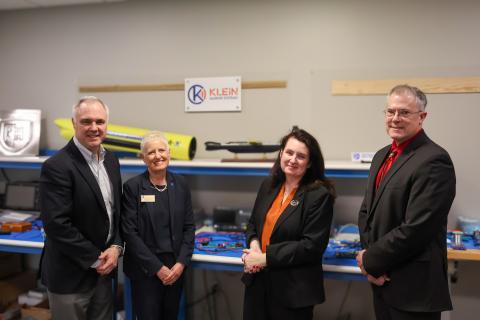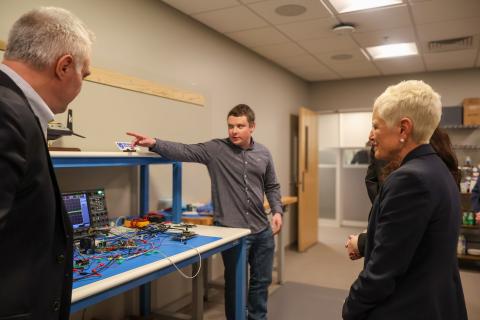
The University of New Hampshire (UNH) welcomes Klein Marine Systems, a global leader in sonar technology, to the thriving network of business partners at the John Olson Advanced Manufacturing Center. On Wednesday, March 12th, Klein dedicated the "Klein Sonar Lab" and renewed its corporate partnership with UNH. To cement this relationship, Klein is lending an MX 600 Side Scan Sonar to UNH's Center for Coastal and Ocean Mapping/Joint Hydrographic Center (CCOM/JHC).
Klein Marine Systems, based in Salem, NH, is a world leader in Sonar Technology with over 60 years of experience; their sonar uses patented ALS (angle look sonar) and GAP filler technology to create a complete and continuous ocean floor map. A sonar's transducers illuminate the sea floor with pings of sound, which then reflect and return with images of the floor. Robert Glover, sales manager for Klein, explains it this way, "Think about shining a light in a dark room and casting a shadow - You don't see the object – you see the shadow it makes." Glover calls this the art of sound, putting a sound wave in the water and watching it return, producing an image with ping after ping.
Traditional sonar is shaped like a torpedo, and its transducers (devices that convert electrical signals to sound) send out waves or pings of sound at an angle, creating a blind spot directly underneath. This blind spot is called the Nadir Gap. Klein's first-to-market ALS and Gap technology fills the Nadir Gap, creating a cohesive image in one pass. UNH students can use Klein's one-of-a-kind sonar to map NH's coastline and study animal habitats while learning about ALS and gap-fill technology. The sonar's presence at the University allows students and researchers to find new applications for this technology. Moreover, Klein's sonar products dominate the global market. Most students will never receive hands-on training like this, giving UNH's scholars a leg up well before graduating.
While CCOM/JHC will utilize the MX 600, the Klein Sonar Lab is located at UNH's John Olson Advanced Manufacturing Center on the west edge. How does aquatic sonar relate to an advanced manufacturing center? Glover explains, "We are really an engineering company. So, we work with clients to deliver a solution that is tailor-made for their specifications." Each customer or client has a different peripheral requirement depending on their use of sonar. Many of Klein's products are bespoke, particularly their products for various global militaries.
The Olson Center's experience with research, development, and prototyping and its grants with the Department of Defense makes it an ideal location for Klein to develop its products. Klein's Vice President and General Manager, Ted Curley, says,
"We are confident that the next generation of Klein sonar technology will be developed at our new Sonar Innovation Lab at the John Olson Center."
The Olson Center's first project with Klein was using an MTS (material tensile testing) machine to strength test Klein's break-away wing. This wing allows a sonar being pulled through the water to break away from the vessel if caught on the ocean floor and later retrieved with minimal damage. The strength test ensured the wing would disengage with the right amount of force, not before or after.
Recently, process engineer Nathan Daigle, with students Connor Bernard, Matthew McCoy, and Ana Ekstrom, built a to-scale 9' model of Klein's 5900 side scan sonar for trade show events. It is the Center's largest model to date, requiring a large-scale Modix 3D printer, 300 hours of printing time, and 20,000 grams of filament versus the average 300 grams it takes for most of the Center's prints. Bernard says of the experience, "It was a fun project because I got to use a larger scale additive printer, improving my skillset." John Roth, Director of the Olson Center, adds, "These significant projects offer interns valuable experiences and demonstrate the real-world applications of their coursework."
Klein's relationship with UNH is not new, but the dedication of the sonar lab revives their presence on campus. Glover champions this relationship: "We're looking forward to getting back to hands-on learning with the students." The excitement is mutual for UNH; Marian McCord, UNH's Vice Provost for Research, says,
"This collaboration is all about driving discovery and innovation in a space where ideas can really take off. We're excited to get to work."
Written by Katie Ahearn

L-R: Ted Curley, vice president and general manager of Klein Marine Systems; Ryan Gill, lead electrical engineer at Klein Marine Systems; Marian McCord, UNH senior vice provost for research, economic engagement and outreach;